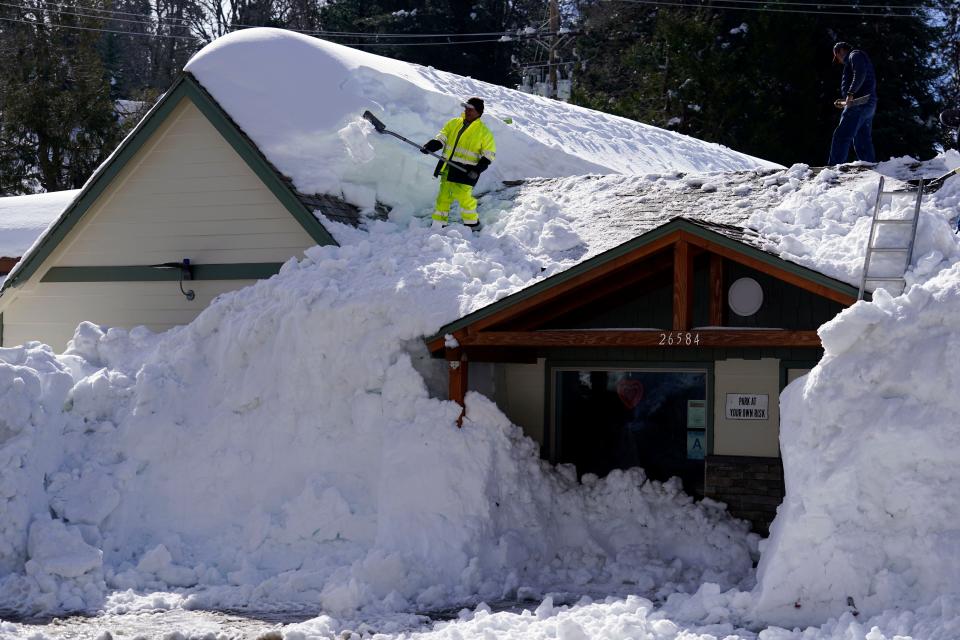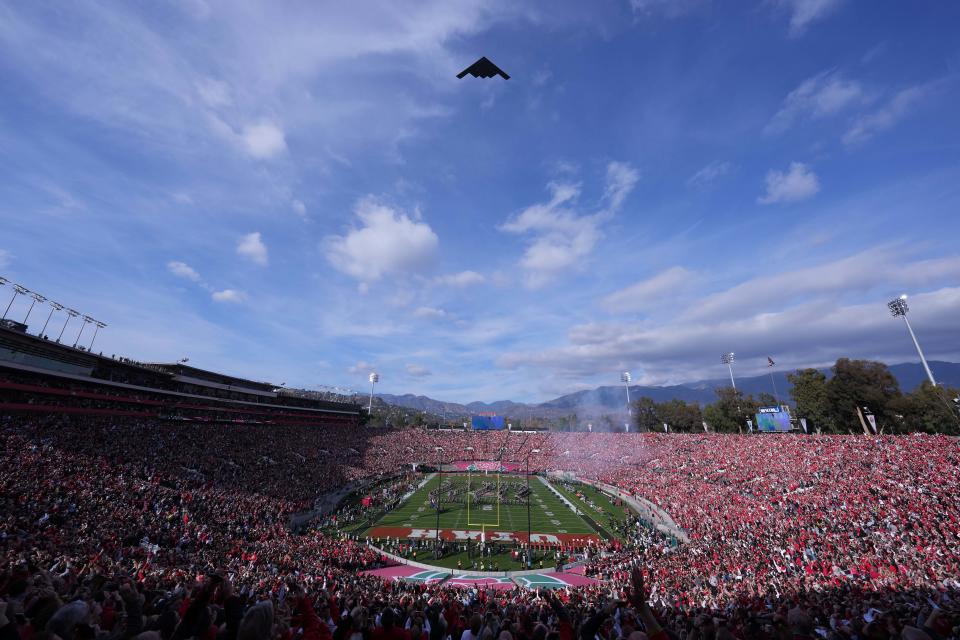Trillions of gallons have soaked California. Is this the state's wettest winter ever?
A colossal amount of rain and snow has fallen on California over the past few months from a dozen atmospheric rivers: more than 78 trillion gallons of water and counting.
It's not the wettest year the Golden State has ever seen, but it is a massive amount of water in a state that has been beset by drought for several years. The number of gallons is according to data from the National Weather Service that was compiled by meteorologist Ryan Maue.
The 78 trillion gallon number is based upon the statewide average of 27.6 inches of rainwater and "snow-water equivalent" that's fallen on the state from Oct. 1 – the beginning of California's water year – to the week of March 20.
"Snow-water equivalent" is the depth of water that would cover the ground if the snow cover was in a liquid state," according to the weather service.
GRAPHICS: See how drenched California is — and why it would take multiple years like this to erase drought

How much water is in 78 trillion gallons?
The precipitation didn't fall evenly across the state, but if it did, it would have covered the state of California with about 30 inches of water. That's enough to:
Fill the Rose Bowl more than 900,000 times.
Fill more than 110 million Olympic-sized swimming pools.
Fill Lake Tahoe – twice.
In case you need a refresher, here's what the Rose Bowl stadium in Pasadena, California, looks like:

How does climate change affect you?: Subscribe to the weekly Climate Point newsletter
READ MORE: Latest climate change news from USA TODAY
Is this the wettest winter California has ever had?
At 27.6 inches so far, California still has quite a way to go to break the record for the wettest year on record: "The largest water year was 1982-1983, which totaled 42.81 inches," said California state climatologist Michael Anderson.
How does California's winter compare to average?
Maue said the statewide long-term average from Oct. 1 to late March is supposed to be 52 trillion gallons of water (18.6 inches statewide). So more than 25 trillion gallons above average have fallen this year – or about 150% of the average.
How does it compare to the past few dry years?
California's wildly wet winter of 2022-23 is in stark contrast to how dry the state has been over the past few years. Last water year, for instance, ended with statewide precipitation at 76% of average, according to the California Department of Water Resources.
So this year has already seen about twice as much precipitation as the entire water year of 2021-22.
In addition, the years 2020-22 were California's "driest three-year period on record, breaking the old record set by the previous drought from 2013 to 2015," according to a news release from WaterWorld magazine.
How much snow has fallen in the California mountains?
Several ski resorts in California and the Western U.S. have seen as much as 58 feet of snow this winter, according to Weather.com. That's about 700 inches of snow.
How do 58 feet stack up? Well, it's taller than the average height of three male giraffes stacked from head to toe, said Weather.com meteorologist Chris Dolce.
(Keep in mind that the 58-foot-total is accumulated snowfall for the entire winter, not the snow depth. Due to melting, evaporation, and compacting, the actual snow depth at any given time was never that high.)
On Wednesday, the Mammoth Mountain ski resort in the eastern Sierra announced that it had set an all-time record of 695 inches (nearly 58 feet) of snow for the season at the resort's main lodge.
PREVIOUSLY: 30 feet of snow? That much has fallen in some places in California as snow blankets huge swaths of state.
More than 57 feet of snow has fallen at the Central Sierra Snow Lab, a University of California, Berkeley field research station located at Donner Pass in California's Sierra Nevada mountains. The normal full-season snowfall total there is about 30 feet.
The 57 feet amount has already shattered a nearly 40-year record held back in 1983.
The heavy snow set another record this week: As of Tuesday, the water content of the central Sierra snowpack was 234% of the April 1 average, a benchmark for its historical peak, according to the state's Department of Water Resources.
One other fun fact from this winter: California transportation officials said earlier this month that they removed so much snow from the state's roadways in February that it would be enough to fill the Rose Bowl 100 times.
What is the US snowfall record?
As incredible as these snowfall totals are, it's still a long way from the nation's all-time snowiest winter of 95 feet, which was set at the Mount Baker Ski Area in Washington state during the winter of 1997-98, according to the National Oceanic and Atmospheric Administration.
Does all this rain and snow end the drought in California?
Not quite.
California's recent rain and snow have helped pull nearly two-thirds of the state out of drought conditions.
In fact, according to the U.S. Drought Monitor, as of March 23, only 36% of the state of California is in a drought, compared with the Jan. 1 mark of 100%.
“Clearly, the amount of water that’s fallen this year has greatly alleviated the drought,” said Daniel Swain, a climate scientist at the University of California, Los Angeles. “It has not ended the drought completely, but we’re in a very different place than we were a year ago.”
However, while the state's drought situation is greatly improved, much of the West still faces a long-term water crisis as experts warn demand for water will keep outpacing the supply of it.
DEFINITIONS: Is climate change the same thing as global warming? Definitions explained.
CLIMATE CHANGE CAUSES: Why scientists say humans are to blame.
Even Los Angeles was soaked this winter
When you think of Los Angeles, rain isn't the first type of weather that comes to mind. However, this winter season has been extraordinarily wet in the city of angels. So far this season, some 21.28 inches of rain has been recorded in downtown LA, the National Weather Service said. That's more than twice the average of almost 9 inches.
Both the months of January and February were especially soggy. In January, 8.95 inches fell, more than double the monthly average of 3.29 inches, the weather service said. In February, rain in downtown LA was 5.95 inches, far above the average of 3.64 inches.
A deadly, costly winter in California
So far, the storms have killed more than 20 people in California and likely caused tens of billions of dollars in damages, according to AccuWeather.
Contributing: The Associated Press
This article originally appeared on USA TODAY: California rain, snow totals: How many inches? What about drought?

 Yahoo Movies
Yahoo Movies 
